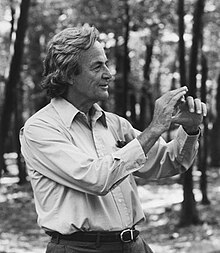Richard Feynman

Richard Feynman (11 May 1918 – 15 February 1988) was an American physicist of Jewish descent. He was part of the Manhattan Project team that made the atomic bomb. Feynman won the Nobel Prize in Physics 1965. He was one of the first people to study quantum physics. Feynman added significantly to a branch of science called quantum electrodynamics and invented the Feynman diagram. He was also one of the first scientists to discuss about the possibility of quantum computers.[1][2]
During World War II, Feynman worked on the Manhattan Project at Princeton University and Los Alamos National Laboratory. At age 24, he was the youngest group leader in the theoretical division and helped create the formula for predicting the energy yield of a nuclear bomb.[3][4]
In 1986, Feynman joined the Rogers Commission Report to investigate the causes of the Space Shuttle Challenger disaster.[5] Feynman's role in the commission was said to have helped it discover the reasons behind the explosion.[5]
Personal life
[change | change source]He was born in Far Rockaway, Queens, New York City. He studied at the Massachusetts Institute of Technology and at Princeton University.
Feynman was married to Arline Greenbaum from 1942 until her death in 1945. He was then married to Mary Louise Bell from 1952 until their divorce in 1958. He was then married to Gweneth Howarth from 1960 until his death. Feynman had two children.
Feynman, who had liposarcoma, died of problems caused by kidney failure in Los Angeles, California on 15 February 1988 at the age of 69.
His sister Joan Feynman (1927–2020) was an astrophysicist.
Writings
[change | change source]Feynman was known for making physics popular through both books and lectures, including a 1959 talk on top-down nanotechnology called There's Plenty of Room at the Bottom and the three-volume publication of his undergraduate lectures, The Feynman Lectures on Physics.
Feynman also became known through his autobiographical books Surely You're Joking, Mr. Feynman! and What Do You Care What Other People Think?, and books written about him such as Tuva or Bust! by Ralph Leighton and the biography Genius: The Life and Science of Richard Feynman by James Gleick.
Selected works
[change | change source]Feynman wrote some best-selling autobiographies, and his lecture notes became popular with physics students and qualified professionals.
- Feynman, Richard P. (1985). Ralph Leighton, ed. Surely You're Joking, Mr. Feynman!: adventures of a curious character. W.W. Norton. ISBN 0-393-01921-7.
- Feynman, Richard P. (1988). Ralph Leighton (ed.). What Do You Care What Other People Think?: further adventures of a curious character. W.W. Norton. ISBN 0-393-02659-0.
- Classic Feynman: all the Adventures of a Curious Character, edited by Ralph Leighton, W.W. Norton, 2005, ISBN 0-393-06132-9. Chronologically reordered omnibus volume of Surely You're Joking, Mr. Feynman! and What Do You Care What Other People Think?, with a bundled CD containing one of Feynman's signature lectures.
- No Ordinary Genius: the illustrated Richard Feynman, ed. Christopher Sykes, W.W. Norton, 1996, ISBN 0-393-31393-X.
- Six Easy Pieces: essentials of physics explained by its most brilliant teacher, Perseus Books, 1994, ISBN 0-201-40955-0.
- Six Not So Easy Pieces: Einstein's relativity, symmetry and space-time, Addison Wesley, 1997, ISBN 0-201-15026-3.
- Feynman: the graphic novel. Jim Ottaviani and Leland Myrick, ISBN 978-1-59643-259-8.
- Feynman, Richard P.; Leighton, Robert B.; Sands, Matthew (1970). The Feynman Lectures on Physics: the definitive and extended edition. Vol. 3 volumes (2nd ed.). Addison Wesley (published 2005). ISBN 0-8053-9045-6. Includes Feynman's Tips on Physics (with Michael Gottlieb and Ralph Leighton), which includes four previously unreleased lectures on problem solving, exercises by Robert Leighton and Rochus Vogt, and a historical essay by Matthew Sands.
References
[change | change source]- ↑ Nielsen, Michael A.; Chuang, Isaac L. (2010). Quantum Computation and Quantum Information (10th anniversary ed.). Cambridge: Cambridge University Press. p. 7. ISBN 978-1-107-00217-3. OCLC 844974180.
- ↑ Rieffel, Eleanor G.; Polak, Wolfgang H. (March 4, 2011). Quantum Computing: A Gentle Introduction. MIT Press. p. 44. ISBN 978-0-262-01506-6.
- ↑ "Richard Feynman". Laphams Quarterly. Retrieved October 14, 2024.
- ↑ "Richard Feynman (1918 - 1988)". Hiroshima Remembered. Retrieved November 4, 2024.
- ↑ 5.0 5.1 "How Legendary Physicist Richard Feynman Helped Crack the Case on the Challenger Disaster". Lithub. Retrieved October 14, 2024.
Other websites
[change | change source]- About Richard Feynman
- 14 minute talk about Dick Feynman by his friend Leonard Susskind
- Gallery of Drawings by Richard P. Feynman Archived 2012-01-12 at the Wayback Machine
- Biography and Bibliographic Resources, from the Office of Scientific and Technical Information, United States Department of Energy
